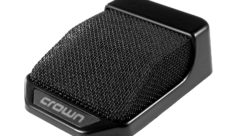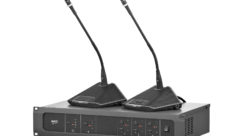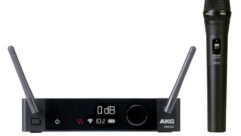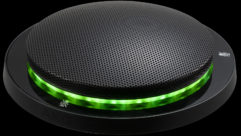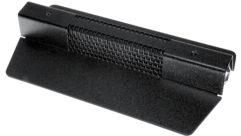

Boundary Mics and Automatic Mic Mixers
Aug 21, 2012 11:45 AM,
By Bob McCarthy
This month’s showcase will feature boundary microphones and automatic mixers. The coupling of these two entities steers us in a decidedly corporate direction, emphasizing conference, podium, courtroom, and boardroom applications. Let’s start at the beginning of the signal path and work our way from mics to mixers.
Astatic/CAD Audio 930VPL
BOUNDARY MICROPHONES

Crown Audio MB3
The principal behind the boundary mic is the same as our reasons for placing a subwoofer on the floor, except in reverse. The idea is to use the reflection constructively to achieve a hemispheric response, which adds 6dB of “free” sound level. In the case of the subwoofer, this is easily achieved since the wavelengths in play are very large. In the case of the boundary mic, the high frequency range is limited by how close we can get to the reflecting surface and still stay within the phase variation required to avoid cancellation. Innovations in transducer technology have brought us closer and closer to the surface, and the modern boundary mic now features a wide variety of patterns and options. Let’s take a closer look at the options available.
If you are looking for an extremely flat boundary mic the AKGMB3 certainly fits the bill. After all, it rises less than half an inch above its mounting surface. The mini-boundary line provides a low-profile solution with supercardioid performance from the company with the longest track record in the field of boundary mics. The MB3 is completely self-contained with the phantom-powered compact electronics mounted inside the tubular assembly. Mounting is accomplished by a single hole drilled in the boundary surface and connection via XLR. An LED on the external grille lights when the mic is hot. Up to four of the MB series mics can optionally be controlled by the MB-100 interface, which provides separate inputs, outputs, and programmable switching connections.
The Astatic/CAD Audio930VPL may look like a garden-variety mouse mic, but there is much more going on here than meets the eye. First is the fact that the polar pattern is continuously variable via a programmable membrane switch, LED, and logic interface. The polar pattern can be optimized for the particular application or environment. Another feature found in the modern creature is immunity from the RFI intrusions of cell phones and other two-way communication devices. The 930VPL features logic I/O functions that can be used with automatic mixers, teleconferencing systems, and control systems. The logic input can remotely control the LED as well as the membrane-switch activation. The 930VPL is primarily designed for speech and vocal pickup in governmental, institutional, religious, and business applications.

Audio-Technica ES947
If you are looking for a clean a simple condenser boundary mic solution, be sure to give a close look at Audio-Technica’s ES947. Make it a very close look or you will miss it since it is just over 1in. in diameter and surface-mounted with a very low profile. The 120-degree cardioid patterned, RFI-protected microphone is ready to run, with little more needed beyond a 1in. hole and a boundary to mount it on. The mic is XLR terminated, and its self-contained power module eliminates the need for additional external in-line electronics. The microphone is protected by a rugged all-metal case with a two-layer steel mesh grille and mounted with provided isolators to reduce vibration noise. The unit is capable of input levels up to 142dB SPL, which makes it ideal for a modern-day town hall meeting. It is available in black and white.
If you are looking for a no frills alternative consider the Peavey PSM 3. This is the traditional mouse shape, with a low profile and is available in black or white. It is as comfortable on the stage as it is in the conference room. The phantom-powered PSM 3 uses multiple condenser capsules to create a directional response, which increases the gain before feedback and reduces ambient noise.

Samson UB1 USB
If you are looking for a boundary mic that can interface directly with your computer the SamsonUB1 USB should be of interest. The UB1 is an omni-directional surface-mount condenser microphone with USB output, compatible with both Mac OS and Windows. The UB1 also ships with Cakewalk Sonar LE digital audio workstation software. The UB1 can be placed on a conference table, podium, altar, or mounted using the keyhole mounting points.

Shure MX392
The ShureMX392 and MX393 Microflex wired boundary Microphones are designed for conference table or stage work. The phantom-powered condenser mics are available in cardioid, supercardioid, and omni models. The MX392 comes with an attached cable, while the 393 is connectorized. They are equipped with features like programmable, silent membrane switches, logic inputs and outputs, and green LED indicators.
1
Boundary Mics and Automatic Mic Mixers
Aug 21, 2012 11:45 AM,
By Bob McCarthy

AKG DMM 4/2/2
AUTOMATIC MIXERS
Let’s move forward in the chain and put these mics to use. Those of us in live audio are still secure in the mindset that the show must go on and our ongoing presence is required. We welcome automation for its repeatability and as an aid to take care of parts of the mix that do not require constant attention. Nonetheless, we know we can do a far better job than a computer at smoothing out the moment-to-moment variations in input signals.
In the world of conference/corporate/legal multi-mic audio this paradigm is turned on its head. First, the mixing complexity is infinite since the sequence of people speaking can be completely unscripted and can change at any moment. Precisely because it is so impossibly complex, the job is turned over to a computer. The modern automatic mixer used in a corporate conference room can listen to every channel individually and discern which channel is carrying the leading signal and tilt the gain structure in favor of keeping that signal at maximum clarity and suppressing the noise of other board members who might be snoring. The moment things change, the mixer will pick up the new leader and bring them to the forefront. That is just the beginning. Feedback suppression, dynamic filtering, and other features are the norm.
The AKGDMM 4/2/2 is a processor-controlled digital automatic mixer with four balanced microphone inputs, two stereo AUX inputs, and one master output. The DMM 4/2/2 is well suited as a standalone solution for small systems, but it is also fully expandable for larger applications. The system incorporates the full suite of automatic mic mixing features such as finding the best mic, last mic on, compression, limiting, and a range of filters. Each channel offers switchable gain (mic/line, mic-lo/mic-hi), switchable phantom power, and an incremental level control with LED level and peak hold display. The automixing and ducking functions can be enabled and disabled for each microphone and AUX channel separately.
The latest offering from Beyerdynamic is the Quinta, named for its status as the fifth-generation wireless conference system. This comprehensive system offers a full suite of automated mixing capabilities and turnkey operation. The basic configuration is standard conferencing system topology: a remote controllable, expandable central processing unit, which serves as the hub for a constellation of remote stations with a microphone and local user controls. Quinta, however, is a comprehensive approach, going far beyond the norms in providing a single-source solution for conferencing. Accessories, for example, include road cases with built-in battery chargers so that the system can be rolled in and deployed at a moment’s notice with no wiring required for the remote stations.
The ease of deployment does not come at the cost of reduced flexibility or performance. The engineering is thoroughly up to date, incorporating even the newly operational AVB standard as well as compliance to an impressive array of network and telecommunications standards. The wireless system operates in three bands (2.4/5.2/5.8GHz) and switches silently as required to maintain optimal signal strength. The system can be controlled remotely via computer or smartphone, but all transmissions are 128-bit encrypted, ensuring that you maintain both control and privacy. The standard array of automatic mixing functions such as voice activation and feedback suppression are included, as well as videoconferencing and voting functions.


Clockaudio MR 88
The ClockaudioMR 88 is a fully digital 8-channel 1RU mixer with an array of DSP capabilities that are too numerous to cover fully here; there are around 16 different adjustable categories for each input and output. For starters we have the prerequisites such as level prioritization, feedback suppression, compression, and expandability. In addition, any of the logic features can be externally controlled, overridden, or modified as needed. The equalization features up to 12dB of boost or cut at 200Hz and 5kHz for each input channel. Each channel has an individual record out for applications such as where individual transcriptions are desired from a meeting or court session. The compression ratios are adjustable in eight steps to provide optimal gain monitoring. The ambient noise threshold is individually adjustable with special settings for voice or music.

Dan Dugan Sound Design Model E-3
The new product this year from Dan Dugan Sound Design is the Model E-3 (which replaces the D-3). The E-3 features eight channels of AES inputs and outputs with speech system, music system, and gain limiting; 14 channels of AES I/O speech system; 16 channels of ADAT I/O with speech system. The unit is operable by the Model CP-2 control panel (eight channels), or software control panels (8-14-16 channels).
The newest addition to Lectrosonic’s ASPEN digital matrix processor family is the SPNDNT (Dante) network processor. Much more than a simple network interface, this full-featured DSP processor can address both the ASPEN and Dante matrices and add mixing, gain, and delay functions to the digital audio signals. Any of the 48 final mixes in the ASPEN matrix can be assigned to any of the Dante channels. Dante signals can also be imported into the ASPEN matrix for mixing with other local and network signals, and then routed onward. Dante products deliver a self-configuring, plug-and-play digital audio network within standard Internet protocols and a migration path to upgrade to new standards such as AVB.


Rane AM2
The RaneAM2 is an eight-input automixer also configurable as a remote audio device, allowing its mix to be sent digitally to a Rane HAL’s RAD port. Once the AM2 mix is in the HAL DSP, additional signal processing such as EQ and compression can be added. Control of the mix’s level using Rane’s DR1 or DR3 digital remotes is possible. The AM2 mixer also digitally cascades into Halogen’s gain-sharing auto mixer or room combine processor. This means the gain-sharing algorithm automatically treats AM2 microphones and any other microphone wired into these DSP blocks as part of the same gain-share. This provides superior gain before feedback since all mics in the room, regardless of where and how they are plugged in to the audio system, work as one. The HAL can accommodate more than 2,000 channels, so expansion is virtually unlimited.

Revolabs Executive HD
RevolabsRevolabs Executive HD system is designed for boardrooms, auditoriums, or anywhere in need of exceptional presentation audio quality. The applications are not limited to a single location. The advanced audio and videoconferencing functions can link one boardroom, house of worship, or venue to the next. Each Executive HD unit provides support for up to eight microphones, and multiple units can be linked together to support at least 32 microphones (per area in the U.S.). The system’s wireless design not only provides users with the freedom of natural movement, it reduces the risks of lawyers tripping on cables and suing the company. One of the down sides of wireless systems is that outsiders can monitor the transmission. The Executive HD puts this concern to rest with its 128-bit encryption of the transmitted signal. The front-panel LCD display provides control and configuration on-location, while management software is available for the convenience of remotely monitoring and controlling the system through its Ethernet and RS-232 connections. With the Executive HD, your investment is future-proofed against government radio frequency changes. Operating outside the UHF spectrum, Revolabs wireless microphones use the DECT personal communication protocol, which is unlicensed and protected for use by consumers.

Sennheiser ADN
Sennheiser offers the ADN conference system, which consists of a central control unit and chairman and delegate satellites. The CU1 central unit can manage up to 400 units and power up to 40 units. The system can be controlled by any of the standard AV media control systems or directly using the provided conference manager software. The ADN C1 chairperson unit and ADN D1 delegate unit have a gooseneck microphone fitted with a Sennheiser supercardioid capsule to suppress unwanted background noise. Each unit has twin speakers to allow each delegate to hear the others while maintaining a low overall level in the room. The discussion units are connected using Cat-5 cables. If additional remote units are required, the ADN PS power supply can be added.
Shure is both a professional microphone manufacturer and an automatic mic mixer manufacturer. The company’s SCM810 is a compact 1RU mixer that handles up to eight microphones. It uses the Shure patented IntelliMix, which performs the mic selection and background noise suppression. The most key requirement of any sound engineer is that no one notices they are doing their work. It is no different for our automated replacements. Therefore something as simple as turning one mic up full and pulling all of the others down will give away the game far too easily and create a distraction for the listeners. The SCM810’ s Last Mic Lock On feature ensures that there is always at least a partially open mic so that there is not a sudden drop out and just as sudden return of ambient noise. The noise adaptive threshold prevents false triggers with circuitry to distinguish between constant background noise (such as HVAC) and the noise of you talking on your cell phone. This 8-channel automatic mixer features adjustable EQ per channel, 48V phantom power, active balanced microphone—or line-level inputs, line-level outputs, highly RF-resistant chassis and circuitry, complete logic control of microphone activation, linking capacity for up to 400 microphones, and an internal power supply.
The TOAD-2000 series digital mixer is designed to provide highly flexible mixing for small to medium-sized applications. Each 2RU unit can be filled with up to 32 channels and can be network for up to 128 total channels. Up to four digital mixing processor units and remote control units can be connected to suit the actual size of the venue. Each unit is controlled via a LAN, enabling decentralized installation. Additionally, customization for a wide variety of applications is smoothly and easily effected, thanks to the eight available slots for input/output modules.
2


